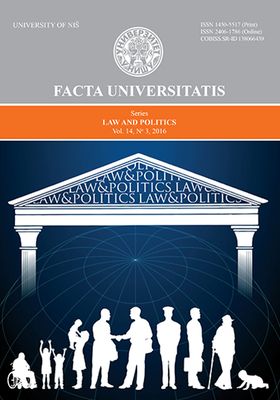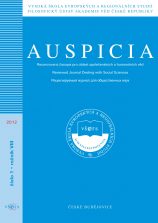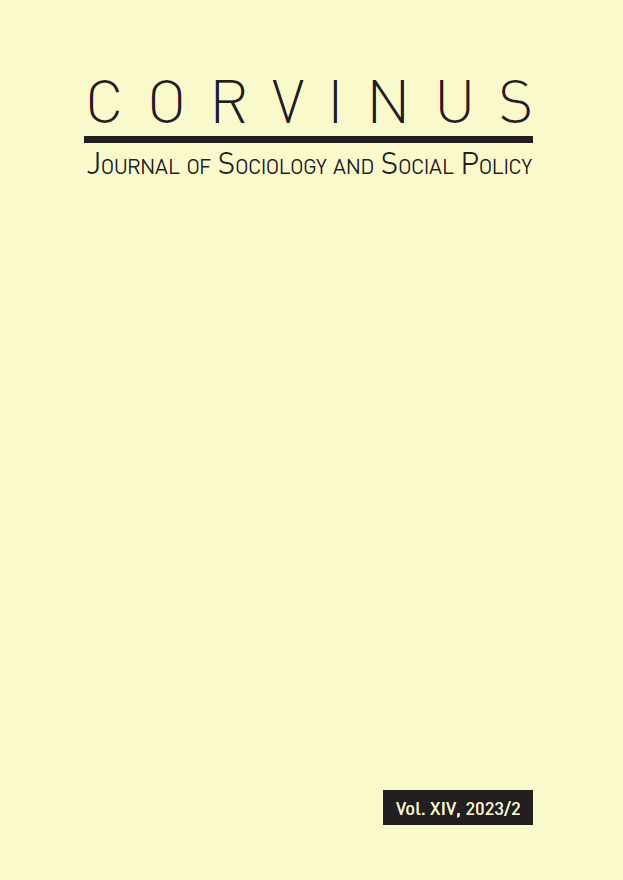
We kindly inform you that, as long as the subject affiliation of our 300.000+ articles is in progress, you might get unsufficient or no results on your third level or second level search. In this case, please broaden your search criteria.

The time in which we live forces us to an accelerated pace of life to which many people cannot adapt, and it also raises the question whether that is the main “culprit” for about 800 000 people worldwide who commit suicide every year. To an accelerated pace of life, as the reason for these devastating statistics, we can add a range of “modern” diseases starting with alcoholism, gambling, depression and addiction to more dangerous drugs, which are not lacking in Bosnia and Herzegovina. All this leads a person in a state in which he/she cannot see the point in anything, has no perspective and simply, cannot find enough reasons to fight, to live. The scientific method of content analysis is used to show that suicide presents a major problem for Bosnia and Herzegovina, which no one talks about. One of the major issues in suicidology of Bosnia and Herzegovina is relationship between PTSD and suicide. Like most characteristics of the psychological state of a person, suicidality can be displayed and observed from several different points of view: psychiatric, sociological, cultural, religious, philosophical, etc. None of the above listed (and unlisted) standpoints can be completely separated from standpoints of other professions and it would be better to say that it is a complex phenomenon which is interpreted and accepted in different ways due to the diversity of professions. Wherever suicide is observed as an objective fact, as a galaxy or an elementary particle, the observer moves further away the more information and facts he gathers.
More...
This paper explains how Poisson regression can be used in studies in which the dependent variable describes the number of occurrences of some rare event such as suicide. After pointing out why ordinary linear regression is inappropriate for treating dependent variables of this sort, we go on to present the basic Poisson regression model and show how it fits in the broad class of generalized linear models. Then we turn to discussing a major problem of Poisson regression known as overdispersion and suggest possible solutions, including the correction of standard errors and negative binomial regression. The paper ends with a detailed empirical example, drawn from our own research on suicide.
More...
The man is a rational being, but its role is increasing in the area of not only the Earth, but the near universe as well, becoming more pronounced and more important. If, until recently, he could not produce the effects that could be seen from space, the modern era has opened up about that possibility as well. The melting ice cover, forest fires, especially armed conflicts, atomic weapons probes, and certainly other types of weapons that interfere with well-established principles of nature are now more than obvious. The man increasingly feels like a ruler, like “the master of nature”. If something is understood as external law unwinding certain phenomena, can we say that we know and the occurrence itself. If we found a curtain over the atoms using the most accurate microscope available, can we say that we have mastered all the secrets of the atom or the infinity of the universe? The arrogance of man was visible immediately after he, or his social group, feel independent. Then comes the competition about merit, and it produces the illusion of progress. The entire previous history is the history of the various conflicts and manifestations of violence.
More...
U St Louisu živi najveća skupina bosanskih izbjeglica u SAD. Sasvim slučajno, St Louis ima i živahnu psihoanalitičku zajednicu, vodi je dr. Todd Dean koji je godinama pro bono pružao pomoć traumatiziranim izbjeglicama. Sve to nagnalo me je otputovati u St Louis, radoznalu istražiti šta se dogodilo s Bosancima/kama 20 godina poslije rata, kroz kakvu vrst trauma prolaze, kako se nose s prošlošću i kako su se snašli u novoj zemlji.
More...
The paper provides detailed reflections on the educational, economic and social circumstances that impact on the lives of many disadvantaged and vulnerable children and young people. Drawing largely on primary research data collected in Romania, Germany and the United Kingdom, three illustrative case studies are presented for consideration focusing on: life in residential care and youth offending institutions; experiences of educational vulnerability; and human trafficking. The methodological approach adopted across the research projects explored, was shaped by the demands and expectations of the United Nations Convention on the Rights of the Child (UNCRC). All of the reported data reflects the views of children and young people who were interviewed as part of three research projects. It is argued that the difficult and challenging circumstances that many children and young people find themselves in, place them at significant disadvantage and increased vulnerability in terms of their social and educational development and life chances.
More...
The aim of this study was to explore internalizing and externalizing problems in adolescent children of veterans of the war in Kosovo (1998-1999). The results of this study are quite interesting from the perspective of the dilemma for the state of the children of veterans even 15 years after the war ended. Parents’ emotional problems affect the functioning of the family in general and children in particular. Children can react to symptoms of parents by developing different symptoms as trouble sleeping, appetite loss, emotional instability or even problems in development, according to research done on children's reactions to the problems of parents explained by interactions between environment, brain and behaviour driven by trauma. The results of this study have shown that the internalizing problems have not shown gender differences, meantime externalizing problems were found higher in male participants. An interesting finding of this study was the highest scores of emotional problems in children born before and during the war, compare to those born after the war ended. We also found that anxiety problems in children [R2= .83, p < .001] were a significant predictor of internalizing problems. The assessment of the scale of positive qualities [R2= .19, p < .001] was also found to be a significant predictor for externalizing problems. Only 0.8% of the variance of internalizing problems was explained by the income. Considering that the subject of this study were adolescent children of war veterans of the 1999 conflict in Kosovo, we must take into account that the post-traumatic stress disorder is a very frequent problem among war veterans and that its impact on their personal and family life cannot be overlooked.
More...
Sexually based offenses, especially those of a pedophilic character, are of great interest to the overall professional and unprofessional public. For some time in the public discourse, there have been attitudes and demands that perpetrators of these crimes receive more severe punishments and other criminal measures. The National Assembly of the Republic of Serbia in 2013 passed the Law on special measures to prevent the perpetration of crimes against the sexual freedom of juveniles, which is colloquially known as Marija’s Law, receiving its name from the minor victim of rape and subsequent death. Through this was established a special criminal justice regime in relation to sexual offenders of a pedophilic orientation. As the characteristics of Marija’s Law may be cited as the introduction of special measures and special records intended for the perpetrators of these crimes. In addition, this Law excludes both in part the modified application of some general criminal law institutes in relation to sexual offenders and those that provide corresponding benefits to offenders of criminal acts.
More...
The subject matter of this article is an analysis of the resolution 819, by which Srebrenica was declared a “safe haven” and measures that could have prevented the fall of Srebrenica. Security Council had proclaimed Srebrenica a “safe haven” with intention to protect Bosnia and Herzegovina, a member state of United Nations, precisely its civilian population in eastern Bosnia. Thus it was a responsibility of Security Council to provide mechanism for protection of Srebrenica, however it failed to do so, and the same thing happened as with resolutions adopted earlier by the Council – it gave no grantee of protection. United Nations may establish peace through peaceful resolvement of conflicts or through collective measures as per chapter VII of the Resolution. For effective application of the Resolution it was necessary to provide for collective measures that could have actually protect Srebrenica, instead it gave only an ostensible protection through mere presence of UNPROFOR with no other power but to protect itself. All the shortcomings regarding the protection of Srebrenica were evident in July 1995, when more than 8 000 people were killed. The verdict of the International Court of Justice declares that the genocide was committed over a protected group of Muslims from Srebrenica and Muslims of eastern Bosnia by the armed forces of Republic of Srpska, whereas Federal Republic of Yugoslavia was found guilty of failing to prevent genocide. Srebrenica should be a lesson to the United Nations so that genocide should never happen again.
More...
domestic violence as a specific form of violence disproportionately affects women and it is a manifestation of discrimination against them. any genderbased violence is a violation of women’s human rights and an indicator of the unequal status of women in the society. in this paper we analyze the specific characteristics of violence against women in the context of post-conflict society in Serbia. Typical value beliefs that encourage violence against women in the socio – cultural environment of Serbia can be divided into: general value beliefs, institutional beliefs and bully’s or abuser’s beliefs. There are many factors correlated with family violence against women with influences that are complex and indirect. These are the structural, cultural, individual and family factors and the attitude towards institutions. Therefore, combating family violence against women has to be recognized as an integrative part of different policies and measures.
More...
During the 1992-1995 Aggression against Bosnia and Herzegovina numerous crimes against civilians and the civilian population were committed, in addition to crimes against the peace and security of mankind in the occupied territories and towns under siege, including the Sarajevo Siege, the capital of the country. Within the study of crimes against humanity and international law, the question of enforced disappearances is of particular interest, taking into account the fact that a large number of forcibly disappeared people who police are still looking for. At the start of the Aggression against Bosnia and Herzegovina, Sarajevo was violently divided into two parts with mass starvation of the civilian population as a common denominator. Military units of the YPA and the VRS were deployed in the occupied parts of the city, where they carried out massive crimes against the civilian population - capture, imprisonment and killing. The total number of forcibly disappeared people in Bosnia and Herzegovina during the 1992-1995 Aggression is 34,965. For another 8,000 people the search is still ongoing. Many families still deprived of exercising their basic humanitarian law - to know the truth about the fate of their loved ones.
More...
The aim of this article is the analysis of the importance of the media in the process of facing the past, overcoming cultural trauma that exists in the area after conflicts and their symbolic representation. First, it examines the role of traditional media in spreading the atmosphere of fear and intolerance before disintegration of Yugoslavia, and then the way in which the new media deals with the shadows of the past. The questions on which there is the most disagreement, regarding the past conflicts in Bosnia and Herzegovina, are analyzed. Who are the perpetrators and the victims of the last war? What is the role of media in conveying the competing visions of the past? Is a struggle for media actually struggle for the control of the meaning of the past? The survey to find the answers to these questions was conducted throughout six-month period and it includes the analysis of twelve web portals in Bosnia and Herzegovina. It is analyzed how the media refers to the past, and how relevant, systematic and responsible way of dealing with topics of traumatic period is. The conclusion is that the topics related to traumatic war events are presented in the media in the same way as other daily political news. The key advantage of the Internet over traditional media, which is reflected in interactivity, has not yet been accepted in BiH society which still prefers to communicate without feedback, insensitive to the needs and opinions of others. In total of 3441 (7.011%) news related to the war on twelve websites in the period of six months, only 46 (0.095%) of them were related to the importance of dealing with the past and reconciliation. The World Wide Web has created tremendous opportunities for improving communication, but deciding factor for development is still social, economic and cultural context in which the media exists.
More...
Article deals with the lives of women, revealing their personal and social problems that can develop in them a sense of being a victim. It is an attempt to show the relationship between the experiences of women and their crime victimization which is a kind of reversal of perspective, the treatment of women – victims of offenders in a category of their own life situation.
More...
The article on The threats of minors in sexual cyberspace, cyberspace - as a platform for sexual threats towards children and adolescents.With technological progress and globalization, many threats are moving from the real world to the virtual world. Sexual threats to minors are also entering cyberspace, but in addition to the old threats, the network also creates newer and newer threats, thus opening the door to criminals who want to use children for their own sexual needs. The aim of this article is to present the threats to minors of a sexual nature that may be encountered in cyberspace. The known and popular threats include pornography, „positive” pedophilia and prostitution - which changed its environment and became cyber-prostitution - and the sale of virginity online. The less known but no less dange- rous ones include child grooming, sextortion and sexting.
More...
Helping those who have experienced trauma exposes the helpers to secondary traumatization. The me- chanisms of its development are most often explained using the cognitive model of trauma processing. The aim of the research is to determine how disturbances of core beliefs and cognitive processing in the form of coping with stress are associated with secondary traumatic stress (STS) and secondary posttraumatic growth (SPTG). The study was conducted among psychologists and social workers (N = 240), working with people after traumatic experiences. Four standardized measurement tools were used. Based on the differential diagnosis, four types of consequences were identified. Discriminant analysis was used to establish the optimal configuration of predictors explaining the differences between the four subgroups. Two significant discriminant functions were significant, each identifies different beliefs and coping strategies. The first is associated with the disruptions of core beliefs about the world and cognitive processing in the form of a non-adaptive strategy; the second—with disturbed beliefs about oneself and adaptation strategies. Our results show a much greater exposure of social workers to the negative consequences of secondary traumatic stress disorder. A system of constant monitoring should be introduced, and the principles of prevention and therapy should be implemented.
More...
Today’s life is characterized by an extremely accelerated development of information and communication technologies. This technicaltechnological phenomenon, like any other phenomenon, has both positive and negative social implications. Its positive aspects are wellknown and are inevitably indisputable. However. as we mentioned, it also has negative sides. Within this work, the subject of analysis will be only one aspect of the negative side of the presence of information and communication technologies in today’s society, i.e. we will deal with the issue of the negative impact of information and communication technologies on one of the most vulnerable groups of our society - children. In this sense, we will analyze the international regulations that regulate the issue of child abuse on the Internet. When it comes to domestic regulations, the subject of the analysis will be focused on four characteristic forms of abuse of children on the Internet (trafficking, peer violence, so-called sexual deviations and theft of personal data), and within the framework of normative regulations that combat them, although above all they prevent such phenomena.
More...
Victomology is a modern and well-developing discipline with a significant research goal. The aim of this article is to get victomology familiar in its historical development, find out its current situation and try to anticipate its future development in the conclusion. During its formation there were the processes of consolidation, data collection, concept formation and introduction of new legislation regarding victims of crime. After the Declaration of Basic Principles of Justice for Victims of Crime was adopted by the UN General Assembly the adaptation of the laws of rights of crime victims followed. Thus the legislation was enriched with the concepts of damages of victims of violent offences, criminal injury compensation, conciliation programmes for both victims and criminals which are considered to be an important support for victims.
More...
In the 21st century, one of the essential roles of the Criminal Code is to protect the rights and interests of crime victims. Criminal law is a complex field that must balance established principles with evolving societal dynamics. This involves various stakeholders, including the state, perpetrators, victims, and civil society, each with differing views on criminal law. The modern era, marked by post-truth narratives and a reputational society, has further complicated matters. Casuistry now prevails over systematic approaches, leading to a disconnect between criminal law’s foundational principles and intended societal outcomes. Contemporary criminal law operates on multiple dimensions, addressing individual, societal, and institutional levels while aiming to balance the interests of these entities. The transition from the “age of information” to the “age of reputation” underscores the importance of information subjected to external evaluation. In the context of harmonizing Ukrainian criminal legislation with EU and Council of Europe norms, it is vital to protect human rights. This aligns with a Committee of Ministers recommendation that recognizes crime as a wrong against society and a violation of individual rights, emphasizing the importance of safeguarding victim rights. Approaching criminal law from a victimological perspective offers unique insights into victim participation in criminal liability, crime qualification, and offender culpability. This perspective encourages assessing the efficacy of criminal law prohibitions and promoting victim engagement in crime control.
More...
The aims of the current research are to present human trafficking and its negative influence on the modern world. The focus of the publication is on the challenges and opportunities in combating the criminal activity associated with it. To achieve that, the authors perform an analysis of the normative base, a documentary analysis and a comparative analysis. Statistical data related to the manifestation of human trafficking are also presented and analyzed. Based on the analysis, recommendations and conclusions were formulated. The article consistently outlines: human trafficking as a global problem - analyzes, reports and current data with information on the topic are considered, analyzing and comparing various indicators related to the relevance of the topic and its display; actions and good practices for prevention – an effective regulatory framework at the European Union (EU) level is presented. The foreign experience outside EU is also outlined as follows: in the United Kingdom (the creation of the Modern Slavery Human Trafficking Unit and the National Referral Mechanism in Identifying and Referring Potential Victims of Modern Slavery), the United States of America (the National Action Plan in Preventing Human Trafficking and the Anti-Trafficking Coordination Team Initiative), Canada (National Strategy to Combat Trafficking); opportunities to overcome human trafficking in the Republic of Bulgaria - proposals were made to improve the combatting human trafficking by updating the current actions and implementing behavioral analysis instruments to identify victims of human trafficking and traffickers involved in its execution. The conducted research highlights the need to combat human trafficking and overcome the challenges associated with it.
More...
The religiosity of people may make them respond positively or negatively to various persons in different social situations. Some scholars claim that religiosity can be positively related to intimate partner violence (IPV), when the dominance of men over women is sanctioned by religion. On the other hand, some other scholars support the view that religiousness is negatively associated with IPV as individuals involved in religious activities tend to be less aggressive and more altruistic and empathetic to their partners. This paper attempts to reveal how the religiosity of husbands and wives may mitigate the former’s violent behaviour against the latter in Tamil Nadu State, India. The findings presented in the paper are arrived at from the analysis of qualitative data collected through selected case studie
More...